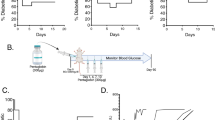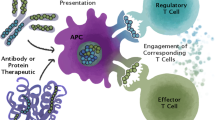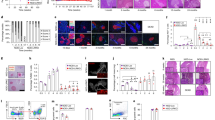Abstract
Antigen therapy may hold great promise for the prevention of autoimmunity; however, most clinical trials have failed, suggesting that the principles guiding the choice of treatment remain ill defined. Here, we examine the antidiabetogenic properties of altered peptide ligands of CD8+ T cells recognizing an epitope of islet-specific glucose-6-phosphatase catalytic subunit–related protein (IGRP206–214), a prevalent population of autoreactive T cells in autoimmune diabetes. We show that islet-associated CD8+ T cells in nonobese diabetic mice recognize numerous IGRP epitopes, and that these cells have a role in the outcome of protocols designed to induce IGRP206–214-specific tolerance. Ligands targeting IGRP206–214-reactive T cells prevented disease, but only at doses that spared low-avidity clonotypes. Notably, near complete depletion of the IGRP206–214-reactive T-cell pool enhanced the recruitment of subdominant specificities and did not blunt diabetogenesis. Thus, peptide therapy in autoimmunity is most effective under conditions that foster occupation of the target organ lymphocyte niche by nonpathogenic, low-avidity clonotypes.
This is a preview of subscription content, access via your institution
Access options
Subscribe to this journal
Receive 12 print issues and online access
$209.00 per year
only $17.42 per issue
Buy this article
- Purchase on Springer Link
- Instant access to full article PDF
Prices may be subject to local taxes which are calculated during checkout






Similar content being viewed by others
References
Wraith, D.C., Smilek, D.E., Mitchell, D.J., Steinman, L. & McDevitt, H.O. Antigen recognition in autoimmune encephalomyelitis and the potential for peptide-mediated immunotherapy. Cell 59, 247–255 (1989).
Metzler, B. & Wraith, D. Inhibition of experimental autoimmune encephalomyelitis by inhalation but not oral administration of the encephalitogenic peptide: influence of MHC binding affinity. Int. Immunol. 5, 1159–1165 (1993).
Liu, G. & Wraith, D. Affinity for class II MHC determines the extent to which soluble peptides tolerize autoreactive T cells in naive and primed adult mice–implications for autoimmunity. Int. Immunol. 7, 1255–1263 (1995).
Anderton, S. & Wraith, D. Hierarchy in the ability of T cell epitopes to induce peripheral tolerance to antigens from myelin. Eur. J. Immunol. 28, 1251–1261 (1998).
Karin, N., Mitchell, D., Brocke, S., Ling, N. & Steinman, L. Reversal of experimental autoimmune encephalomyelitis by a soluble peptide variant of a myelin basic protein epitope: T cell receptor antagonism and reduction of interferon γ and tumor necrosis factor α production. J. Exp. Med. 180, 2227–2237 (1994).
Weiner, H. Double-blind pilot trial of oral tolerization with myelin antigens in multiple sclerosis. Science 259, 1321–1324 (1993).
Trentham, D. et al. Effects of oral administration of type II collagen on rheumatoid arthritis. Science 261, 1727–1730 (1993).
McKown, K. et al. Lack of efficacy of oral bovine type II collagen added to existing therapy in rheumatoid arthritis. Arthritis Rheum. 42, 1204–1208 (1999).
Pozzilli, P. et al. No effect of oral iinsulin on residual beta-cell function in recent-onset type 1 diabetes (the IMDIAB VII). IMDIAB Group. Diabetologia 43, 1000–1004 (2000).
Group. D.P.T.-T.D.S. Effects of insulin in relatives of patients with type 1 diabetes mellitus. N. Engl. J. Med. 346, 1685–1691 (2002).
Kappos, L. et al. Induction of a non-encephalitogenic type 2 T helper-cell autoimmune response in multiple sclerosis after administration of an altered peptide ligand in a placebo-controlled, randomized phase II trial. Nat. Med. 6, 1176–1182 (2000).
Bielekova, B. et al. Encephalitogenic potential of the myelin basic protein peptide (amino acids 83–99) in multiple sclerosis: results of a phase II clinical trial with an altered peptide ligand. Nat. Med. 6, 1167–1175 (2000).
Amrani, A. et al. Progression of autoimmune diabetes driven by avidity maturation of a T-cell population. Nature 406, 739–742 (2000).
Santamaria, P. Effector lymphocytes in autoimmunity. Curr. Opin. Immunol. 13, 663–669 (2001).
Liblau, R., Wong, S., Mars, L. & Santamaria, P. Autoreactive CD8+ T-cells in organ-specific autoimmunity: emerging targets for therapeutic intervention. Immunity 17, 1–6 (2002).
Lieberman, S. & DiLorenzo, T. A comprehensive guide to antibody and T-cell responses in type 1 diabetes. Tissue Antigens 62, 359–377 (2003).
Santamaria, P. et al. β-cell-cytotoxic CD8+ T cells from nonobese diabetic mice use highly homologous T cell receptor α-chain CDR3 sequences. J. Immunol. 154, 2494–2503 (1995).
Verdaguer, J. et al. Acceleration of spontaneous diabetes in TCR-β-transgenic nonobese diabetic mice by β-cell cytotoxic CD8+ T cells expressing identical endogenous TCR-α chains. J. Immunol. 157, 4726–4735 (1996).
Verdaguer, J. et al. Spontaneous autoimmune diabetes in monoclonal T cell nonobese diabetic mice. J. Exp. Med. 186, 1663–1676 (1997).
DiLorenzo, T. et al. Major histocompatibility complex class I-restricted T cells are required for all but the end stages oof diabetes development in nonobese diabetic mice and a use prevalent T cell receptor alpha chain gene rearrangement. Proc. Natl Acad. Sci. USA 95, 12538–12543 (1998).
Anderson, B., Park, B.J., Verdaguer, J., Amrani, A. & Santamaria, P. Prevalent CD8+ T cell response against one peptide/MHC complex in autoimmune diabetes. Proc. Natl Acad. Sci. USA 96, 9311–9316 (1999).
Amrani, A. et al. Expansion of the antigenic repertoire of a single T cell receptor upon T cell activation. J. Immunol. 167, 655–666 (2001).
Lieberman, S. et al. Identity of the beta cell antigen targeted by a prevalent population of pathogenic CD8+ T cells in autoimmune diabetes. Proc. Natl Acad. Sci. USA 100, 8384–8388 (2003).
Trudeau, J.D. et al. Prediction of spontaneous autoimmune diabetes in NOD mice by quantification of autoreactive T cells in peripheral blood. J. Clin. Invest. 111, 217–223 (2003).
Martin, C. et al. Cloning and characterization of the human and rat islet-specific glucose-6-phosphatase catalytic subunit-related protein (IGRP) genes. J. Biol. Chem. 276, 25197–25204 (2001).
Pociot, F. & McDermott, M. Genetics of type 1 diabetes mellitus. Genes Immun. 3, 235–249 (2002).
Aichele, P. et al. Peptide-induced T-cell tolerance to prevent autoimmune diabetes in a transgenic mouse model. Proc. Natl Acad. Sci. USA 91, 444–448 (1994).
Toes, R., Offringa, R., Blom, R., Melief, C. & Kast, W. Peptide vaccination can lead to enhanced tumor growth through specific T-cell tolerance induction. Proc. Natl Acad. Sci. USA 93, 7855–7860 (1996).
Wong, F.S. et al. Identification of an MHC class I-restricted autoantigen in type 1 diabetes by screening an organ-specific cDNA library. Nat. Med. 9, 1026–1031 (1999).
Metzler, B., Anderton, S., Manickasingham, S. & Wraith, D. Kinetics of peptide uptake and tissue distribution following a single intranasal dose of peptide. Immunol. Invest. 29, 61–70 (2000).
Alexander-Miller, M., Leggatt, G. & Berzofsky, J. Selective expansion of high- or low-avidity cytotoxic T-lymphocytes and efficacy for adoptive immunotherapy. Proc. Natl Acad. Sci. USA 93, 4102–4107 (1996).
Perez-Diez, A., Spiess, P., Restifo, N., Matzinger, P. & Marincola, F. Intensity of the vaccine-elicited immune response determines tumor clearance. J. Immunol. 168, 338–347 (2002).
Zeh, H., Perry-Lalley, D., Dudley, M., Rosenberg, S. & Yang, J. High avidity CTLS for two self-antigens demonstrate superior in vitro and in vivo anti-tumor efficacy. J. Immunol. 162, 989–994 (1999).
Arif, S. et al. Autoreactive T cell responses show proinflammatory polarization in diabetes but a regulatory phenotype in health. J. Clin. Invest. 113, 451–463 (2004).
Nicholson, L.B., Greer, J.M., Sobel, R.A., Lees, M.B. & Kuchroo, V.K. An altered peptide ligand mediates immune deviation and prevents autoimmune encephalomyelitis. Immunity 3, 397–405 (1995).
Gross, D.A. et al. High vaccination efficiency of low-affinity epitopes in antitumor immunotherapy. J. Clin. Invest. 113, 425–433 (2004).
Acknowledgements
We thank T. Utsugi for Takeda recombinant IL-2, L. Allen, S. Bou, M. Deuma, C. Fehr and T. Trinh for animal care and technical assistance, and T. DiLorenzo, U. Walter and Y. Yang for feedback on the manuscript. This work was supported by the Canadian Institutes of Health Research, the Juvenile Diabetes Research Foundation (JDRF), and the Natural Sciences and Engineering Research Council of Canada. A.A. was supported by the JDRF and the Alberta Heritage Foundation for Medical Research (AHFMR), J.Y. by the JDRF, and P. Serra and B. Han by the AHFMR. A.F.M.M. and L.E.-K. were supported by the Mathematics of Information Technology and Complex Systems (MITACS) Network of Centers of Excellence. P. Santamaria is a Scientist of the AHFMR and a member of MITACS. The JMDRC is supported by the Diabetes Association (Foothills).
Author information
Authors and Affiliations
Corresponding author
Ethics declarations
Competing interests
The authors declare no competing financial interests.
Supplementary information
Supplementary Table 1
IGRP-specific peptide library (PDF 13 kb)
Supplementary Table 2
Amounts of IFN-γ (pg/ml) secreted by islet-derived CD8+ T cells (PDF 33 kb)
Supplementary Table 3
Amounts of IFN-γ (pg/ml) secreted by islet-derived CD8+ T cells (PDF 36 kb)
Rights and permissions
About this article
Cite this article
Han, B., Serra, P., Amrani, A. et al. Prevention of diabetes by manipulation of anti-IGRP autoimmunity: high efficiency of a low-affinity peptide. Nat Med 11, 645–652 (2005). https://doi.org/10.1038/nm1250
Received:
Accepted:
Published:
Issue Date:
DOI: https://doi.org/10.1038/nm1250
This article is cited by
-
Autoimmune diseases: targets, biology, and drug discovery
Acta Pharmacologica Sinica (2024)
-
Auto-antigen and Immunomodulatory Agent–Based Approaches for Antigen-Specific Tolerance in NOD Mice
Current Diabetes Reports (2021)
-
An altered CD8+ T cell epitope of insulin prevents type 1 diabetes in humanized NOD mice
Cellular & Molecular Immunology (2019)
-
Antigen-specific therapeutic approaches for autoimmunity
Nature Biotechnology (2019)
-
IC-Tagging methodology applied to the expression of viral glycoproteins and the difficult-to-express membrane-bound IGRP autoantigen
Scientific Reports (2018)



